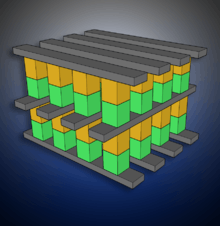3D XPoint
| Computer memory types |
|---|
| Volatile |
| RAM |
| In development |
| Historical |
|
| Non-volatile |
| ROM |
| NVRAM |
| Early stage NVRAM |
| Mechanical |
| In development |
| Historical |
|

3D XPoint (pronounced three dee cross point[1]) is a non-volatile memory technology announced by Intel and Micron in July 2015. Intel refers to future storage devices using the technology under the name Optane while Micron uses the name QuantX.
Details of the materials and physics of operation were not disclosed. Bit storage is based on a change of bulk resistance, in conjunction with a stackable cross-gridded data access array.
Compared to NAND memory Intel claims 10x lower latency, 3x write endurance, 4x writes per second performance improvement, 3x reads per second, and 30% power usage.[2][3]
Micron's vice president of storage solutions stated, "3D Crosspoint will be about half the price of DRAM, but around four to five times more expensive than NAND flash."[4]
Background and description
Development of 3D XPoint began around 2012.[5] Intel and Micron had developed other non-volatile phase-change memory (PCM) technologies previously;[note 1] Mark Durcan of Micron said 3D XPoint architecture differs from previous offerings of PCM, and uses chalcogenide materials for both selector and storage parts of memory cell that are faster and more stable than traditional PCM materials like GST.[7]
As of 2015 full details of the technology had not been given by Intel or Micron, though the technology had been stated to be "not based on electrons".[8] 3D XPoint has been stated to use electrical resistance and to be bit addressable.[9] Similarities to the resistive random-access memory under development by Crossbar Inc. have been noted, but 3D XPoint storage physics is different.[5] 3D XPoint developers indicate that it is based on "changes in resistance of the bulk material.[10] Intel CEO Brian Krzanich responded to ongoing questions on the XPoint material that the switching was based on "bulk material properties".[11] Intel has stated that 3D XPoint does not use a phase-change or memristor technology.[12]
According to a recent article, "no other supplier appears to have a working Resistive RAM/Phase-Change Memory technology that is sampling and matches XPoint's performance and endurance capabilities."[13]
Individual data cells do not need a transistor, so packing density will be 4 times greater than DRAM.[14]
Production
Initially, a wafer fab in Lehi, Utah, operated by IM Flash Technologies LLC (an Intel-Micron joint venture) made small quantities of 128 Gbit chips in 2015. They stack two 64 Gbit planes.[5][15] In early 2016 Guy Blalock, CEO of IM Flash, stated that mass production of the chips was still 12 to 18 months away.[16]
In mid 2015 Intel announced the Optane brand for storage products based on 3D XPoint technology,[17] The anticipated price per bit was expected to be higher than NAND and lower than DRAM, though dependent on the final product.[18]
In early 2016 IM Flash announced that the first generation of solid-state drives will achieve 95000 IOPS throughput with 9 microsecond latency.[16] At Intel Developer Forum 2016 demonstrated PCI Express (PCIe) 140GB development boards showing 2.4-3x improvement in benchmarks compared to PCIe NAND SSDs.[19]
See also
Notes
References
- ↑ "3D XPoint™ Technology Revolutionizes Storage Memory", www.youtube.com (video, infomercial), Intel
- ↑ Demerjian, Charlie (Sep 12, 2016). "Intel's Xpoint is pretty much broken. In their own words it isn't close to the promises". semiaccurate.com. Retrieved 15 November 2016.
- ↑ https://hubb.blob.core.windows.net/5a741d00-0c8a-45e4-9112-cfe073fe4ed1-published/3fde87a3-3307-485e-8528-2c1f6436d737/MASTC01%20-%20MASTC01_-_SF16_MASTC01_102?sv=2014-02-14&sr=c&sig=QY6WHaQ267MeMFMaYT%2BfUJuBzMTkEwjrsv7%2BCzSr6pY%3D&se=2016-10-09T17%3A50%3A09Z&sp=r
- ↑ "Micron reveals marketing details about 3D XPoint memory QuantX". Retrieved 14 October 2016.
- 1 2 3 Clarke, Peter (28 July 2015), "Intel, Micron Launch "Bulk-Switching" ReRAM", www.eetimes.com
- ↑ McGrath, Dylan (28 Oct 2009), "Intel, Numonyx claim phase-change memory milestone", www.eetimes.com
- ↑ Clarke, Peter (31 July 2015), "Patent Search Supports View 3D XPoint Based on Phase-Change", www.eetimes.com
- ↑ Neale, Ron (14 Aug 2015), "Imagining What's Inside 3D XPoint", www.eetimes.com
- ↑ Hruska, Joel (29 July 2015). "Intel, Micron reveal Xpoint, a new memory architecture that could outclass DDR4 and NAND". ExtremeTech.
- ↑ Clarke, Peter (28 July 2015), "Intel, Micron Launch "Bulk-Switching" ReRAM", www.eetimes.com,
"The switching mechanism is via changes in resistance of the bulk material," was all Intel would add in response to questions sent via email.
- ↑ Merrick, Rick, "Intel's Krzanich: CEO Q&A at IDF", www.eetimes.com, p. 2
- ↑ Mellor, Chris (28 July 2015). "Just ONE THOUSAND times BETTER than FLASH! Intel, Micron's amazing claim". The Register.
An Intel spokesperson categorically denied that it was a phase-change memory process or a memristor technology. Spin-transfer torque was also dismissed
- ↑ By Chris Mellor, The Register. “Goodbye: XPoint is Intel's best exit from NAND production hell.” April 21, 2016. April 22, 2016.
- ↑ "Intel's Xpoint is pretty much broken". Retrieved 8 October 2016.
- ↑ Smith, Ryan (18 August 2015), "Intel Announces Optane Storage Brand For 3D XPoint Products", www.anandtech.com,
products will be available in 2016, in both standard SSD (PCIe) form factors for everything from Ultrabooks to servers, and in a DIMM form factor for Xeon systems for even greater bandwidth and lower latencies. As expected, Intel will be providing storage controllers optimized for the 3D XPoint memory
- 1 2 Merrick, Rick (14 Jan 2016), "3D XPoint Steps Into the Light", EE Times
- ↑ Smith, Ryan (18 Aug 2015), "Intel Announces Optane Storage Brand For 3D XPoint Products", AnandTech
- ↑ Evangelho, Jason (28 July 2015). "Intel And Micron Jointly Unveil Disruptive, Game-Changing 3D XPoint Memory, 1000x Faster Than NAND".
Intel's Rob Crooke explained, 'You could put the cost somewhere between NAND and DRAM.'
- ↑ Cutress, Ian (26 August 2016). "Intel's 140GB Optane 3D Xpoint PCIe SSD Spotted at IDF". Anandtech. Retrieved 26 August 2016.
External links
- "Intel Micron Webcast", www.youtube.com, 44 mins
- Third party criticism of Intel failing to meet initial specs